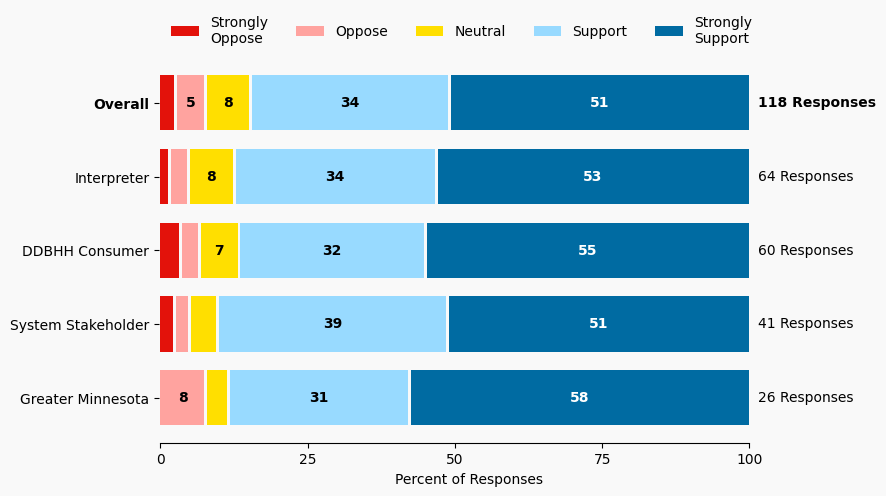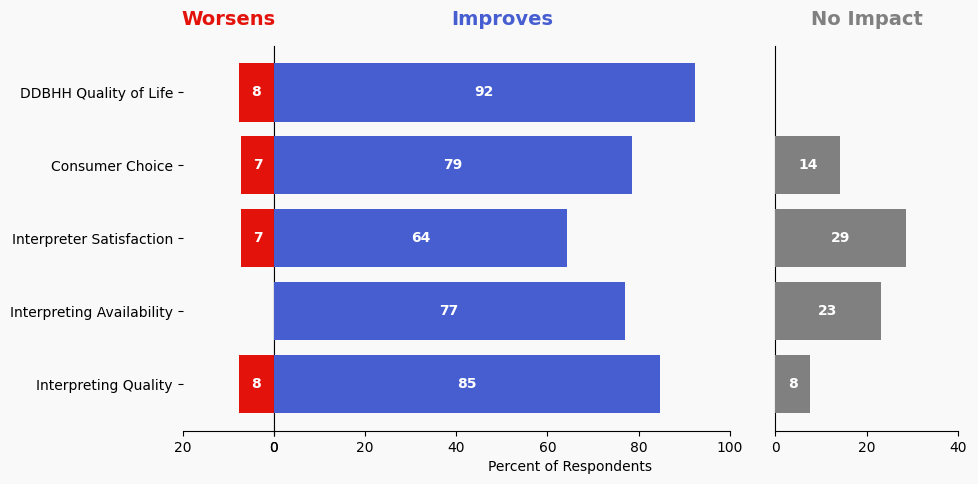57 Seek or Create a Grant to Assess Medical VRI Services Statewide
Issue: Standards are nonexistent for VRI in healthcare settings
Proposed Solution: As VRI services in healthcare settings are non-standardized nor regulated, the coalition, with the Minnesota Department of Health as the lead for this project, will seek a grant to conduct a statewide VRI in medical settings assessment. The grant would hire a contractor to travel throughout the state, evaluating VRI equipment and clinic protocols for its usage. Contractor reports to the Minnesota Interpreting Coalition and the relevant medical system with a scorecard and recommendations for each setting. From these reports, the Commission determines necessary policy changes and ensures their implementation. Conduct routine checks (every 2 years) thereafter.
Expected outcome: DDBHH patients will gain better health outcomes due to better communication access.
Who is impacted: Consumers, VRI interpreters, VRI providers, healthcare systems
Timeline: 6 months

Summary of Support Image Description
The stacked bar charts show how respondents rated their level of support and the total number of responses. The percentage for the five support levels is shown from left to right: Strongly Oppose (Dark Red), Oppose (Light Red), Neutral (Yellow), Support (Light Blue), and Strongly Support (Dark Blue).
Respondents may identify with multiple subgroups. The overall level of support is:
Overall
Strongly Oppose: 3%
Oppose: 5%
Neutral: 8%
Support: 34%
Strongly Support: 51%
Click to see the detailed image description for each subgroup.
Interpreter
Strongly Oppose: 2%
Oppose: 3%
Neutral: 8%
Support: 34%
Strongly Support: 53%
Greater Minnesota
Strongly Oppose: 0%
Oppose: 8%
Neutral: 4%
Support: 31%
Strongly Support: 57%
DDBHH Consumer
Strongly Oppose: 3%
Oppose: 3%
Neutral: 7%
Support: 32%
Strongly Support: 55%
System Stakeholder
Strongly Oppose: 2%
Oppose: 2%
Neutral: 5%
Support: 39%
Strongly Support: 51%
Overview of Respondents Opting for In-Depth Solution Analysis
After indicating their support level, 10% of the 118 respondents opted in to further assess whether the solution would worsen or improve on five metrics. Of the opt-in reviewers (12 respondents), 83% supported the solution, 8% were neutral on the solution, and 8% opposed the solution.
The remaining 106 respondents did not opt in to further assess the solution. Of these people, 84% support the solution, 7% were neutral on the solution, and 7% opposed the solution.
Reviewer Evaluation of Solution Effectiveness

Solution Effectiveness Image Description
The stacked bar charts show how respondents assessed the effectiveness of this solution based on five metrics. For each metric, the percentage of respondents is shown from left to right: Worsens (Red), Improves (Blue), No Impact (Gray).
DDBHH Quality of Life
Makes It Worse 7%
Makes It Better 92%
No Impact 0%
Interpreter Satisfaction
Makes It Worse 7%
Makes It Better 64%
No Impact 28%
Consumer Choice
Makes It Worse 7%
Makes It Better 78%
No Impact 14%
Interpreting Availability
Makes It Worse 0%
Makes It Better 76%
No Impact 23%
Interpreting Quality
Makes It Worse 7%
Makes It Better 84%
No Impact 7%
Reviewer Feedback and Insights
Interpreter
No comments were submitted.
Deaf, DeafBlind, Hard of Hearing
omments from DDBHH Consumers emphasize the need for screening VRI services and interpreters to ensure communication quality and medical knowledge. One comment suggests conducting surveys to assess where and how VRI is being used, ensuring quality, and transparency in VRI services. Another comment expresses concerns about the potential for VRI being seen as a universal solution rather than considering individual preferences for on-site interpreting. One comment indicates there is a need for resources to help medical offices, such as dental and optometry practices, to access ASL interpreters.
System Stakeholder
Comments from System stakeholders suggest conducting surveys with both VRI users and medical facilities to gather data on the effectiveness of VRI. Comments call for assessing where VRI is being used, how much, and gathering feedback to ensure quality communication.
PREVIOUS SOLUTION
56 Educate Health Care Systems on the Best and Inadvisable Uses of VRI
Issue: Lack of standardization on VRI in healthcare settings
NEXT SOLUTION
Issue: Interpreter shortage; amplified in Greater Minnesota
Leave a Reply